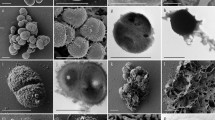Abstract
Calderobacterium hydrogenophilum is an extreme thermophilic, obligately chemoautotrophic, hydrogen-oxidizing bacterium. The cells were shown to be nonmotile straight rods of average size 0.4x2.5 μm. After negative-staining of the whole cells, no flagella were observed. The multilayered cell wall was of type 1 and possessed a crystalline proteinaceous surface layer exhibiting p4 symmetry. The square unit cells had a lattice constant of approximately 11 nm. Cell division occurred by a constriction mechanism. C. hydrogenophilum differred from a similar hydrogen-oxidizing eubacterium, Hydrogenobacter thermophilus, by the absence of intracytoplasmic membrane structures in chemically fixed cells. However, an electron-dense intracytoplasmic hemispherical structure adhering to the inner membrane was frequently observed.
Similar content being viewed by others
References
Anděra L, Mikulík K, Branny P, Puscheva MA (1991) DNA-dependent RNA polymerase from an extremely thermophilic hydrogen-oxidizing bacterium Calderobacterium hydrogenophilum. Biochem Biophys Res Commun 175:949–954
Anděra L, Mikulík K, Savelieva ND (1993) Characterization of a reverse gyrase from the extremely thermophilic hydrogen-oxidizing eubacterium Calderobacterium hydrogenophilum. FEMS Microbiol Lett 110:107–112
Bonjour F, Aragno M (1986) Growth of thermophilic, obligately chemolithoautotrophic hydrogen-oxidizing bacteria related to Hydrogenobacter with thiosulfate and elemental sulfur as electron and energy source. FEMS Microbiol Lett 35:11–15
Bowien B, Schlegel HG (1981) Physiology and biochemistry of aerobic hydrogen-oxidizing bacteria. Ann Rev Microbiol 35: 405–452
Chalcroft JP, Engelhardt H, Baumeister W (1986) Three-dimensional structure of regular surface layer from Pseudomonas acidovorans. Arch Microbiol 144:196–200
Dubochet J, McDowall AW, Menge B, Schmid EN, Lickfeld KG (1983) Electron microscopy of frozen-hydrated bacteria. J Bacteriol 155:381–390
Hobot JA, Villiger W, Escaig J, Maeder M, Ryter A, Kellenberger E (1985) Shape and fine structure of nucleoids observed on sections of ultrarapidly frozen and cryosubstituted bacteria. J Bacteriol 162:960–971
Huber R, Wilharm T, Huber D, Trincone A, Burggraf S, Koenig H, Rachel R, Rockinger I, Fricke H, Stetter KO (1992) Aquifex pyrophilus gen. nov., sp. nov., represents a novel group of marine hyperthermophilic hydrogen-oxidizing bacteria. Syst Appl Microbiol 15:340–351
Igarashi Y, Kodama T (1990) Hydrogenobacter thermophilus: its unusual physiological properties and phylogenic position in the microbial world. FEMS Microbiol Rev 87:403–406
Kawasumi T (1989) Genus Hydrogenobacter Kawasumi, Igarashi, Kodama and Minoda 1984, 9VP In: Staley JT, Bryant MP, Pfenning N, Holt JG (eds) Bergey's manual of systematic bacteriology, vol 3. Williams & Wilkins, Baltimore, pp 1872–1873
Kawasumi T, Igarashi Y, Kodama T, Minoda Y (1980) Isolation of strictly thermophilic and obligately autotrophic hydrogen bacteria. Agric Biol Chem 44:1985–1986
Kawasumi T, Igarashi Y, Kodama T, Minoda Y (1984) Hydrogenobacter thermophilus gen. nov., sp. nov., an extremely thermophilic, aerobic, hydrogen-oxidizing bacterium. Int J Syst Bacteriol 34:5–10
Kellenberger E, Ryter A, Séchaud J (1958) Electron microscope study of DNA-containing plasma. II. Vegetative and mature phage DNAs compared with normal bacterial nucleoid in different physiological states. J Biophys Biochem Cytol 4:671–674
Kristjansson VK, Ingason A, Alfredsson GA (1985) Isolation of thermophilic obligately autotrophic hydrogen-oxidizing bacteria, similar to Hydrogenobacter thermophilus, from Icelandic hot springs. Arch Microbiol 140:321–325
Kruykov VR, Savelyeva ND, Puscheva MA (1983) Calderobacterium hydrogenophilum, an extreme thermophilic bacterium and its hydrogenase activity. Mikrobiologiia 52:781–788
Mikulík K, Anděrová M (1994) Role of polyamines in the binding of initiator tRNA to the 70S ribosomes of extreme thermophilic bacterium Calderobacterium hydrogenophilum. Arch Microbiol 161:508–513
Mikulík K, Qiao Ch-L, Petřík T, Puscheva MA, Zavarzin GA (1988) Elongation factor Tu of the extreme thermophilic hydrogen oxidizing bacterium Calderobacterium hydrogenophilum. Biochem Biophys Res Commun 155:384–391
Mikulík K, Jiráňová A, Maňas J, Spížek J, Anděra L, Savelieva ND (1990) Polypeptide synthesis on ribosomes of an extreme thermophilic hydrogen bacterium Calderobacterium hydrogenophilum. Arch Microbiol 153:248–253
Nanninga N, Brakenhoff GJ, Meijer M, Woldringh CL (1984) Bacterial anatomy in retrospect and prospect. Antonie van Leeuwenhoek 50:433–460
Nishihara H, Igarashi Y, Kodama T (1989) Isolation of an obligately chemolithoautotrophic, halophilic and aerobic hydrogen-oxidizing bacterium from marine environment. Arch Microbiol 152:39–43
Nishihara H, Igarashi Y, Kodama T (1990) A new isolate of Hydrogenobacter, an obligately chemolithoautotrophic, thermophilic, halophilic, and aerobic hydrogen-oxidizing bacterium from seaside saline hot spring. Arch Microbiol 153:249–298
Reynolds ES (1963) The use of lead citrate at high pH as an electron-opaque stain in electron microscopy. J Cell Biol17:208–212
Schlegel HG, Kaltwasser H, Gottschalk G (1961) Ein Submersverfahren zur Kultur Wasserstoff-oxidierender Bakterien: wachstumsphysiologische Untersuchung. Arch Mikrobiol 38:209–222
Tamaoka J, Ha D-M, Komegata K (1987) Reclassification of Pseudomonas acidovorans den Dooren, de Jong 1926 and Pseudomonas testosteroni Marcus and Talay 956 as Comamonas acidovorans comb. nov. and Comamonas testosteroni comb. nov., with an amended description of the genus Comamonas. Int. J Syst Bacteriol 37:52–59
Walther-Mauruschat A, Aragno M, Mayer F, Schlegel HG (1977) Micromorphology of gram-negative hydrogen bacteria. Arch Microbiol 114:101–110
Author information
Authors and Affiliations
Rights and permissions
About this article
Cite this article
Ludvík, J., Benada, O. & Mikulík, K. Ultrastructure of an extreme thermophilic hydrogen-oxidizing bacterium Calderobacterium hydrogenophilum . Arch. Microbiol. 162, 267–271 (1994). https://doi.org/10.1007/BF00301849
Received:
Accepted:
Issue Date:
DOI: https://doi.org/10.1007/BF00301849




